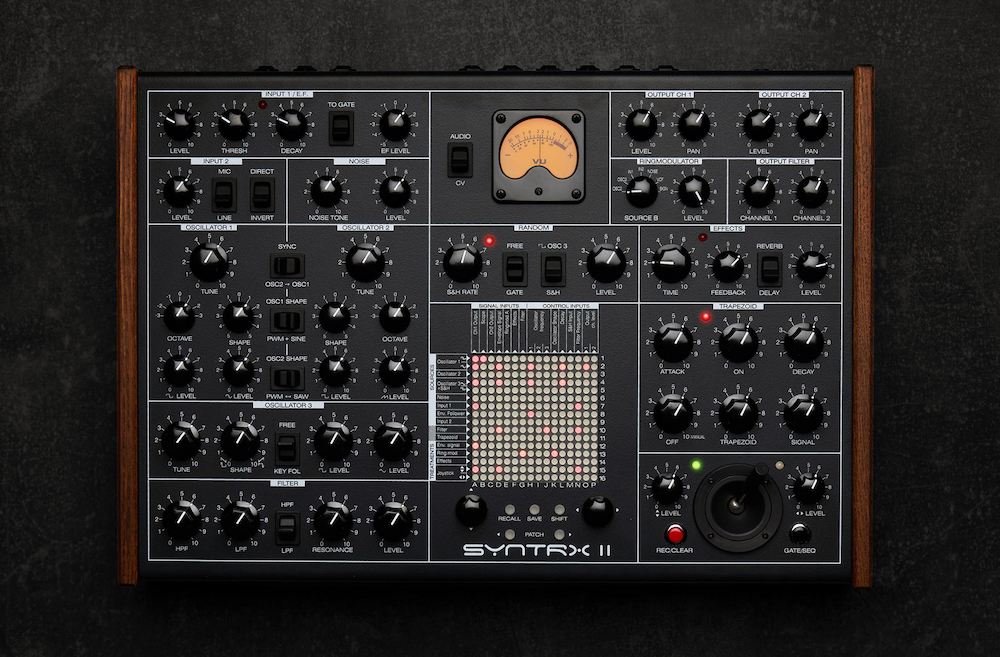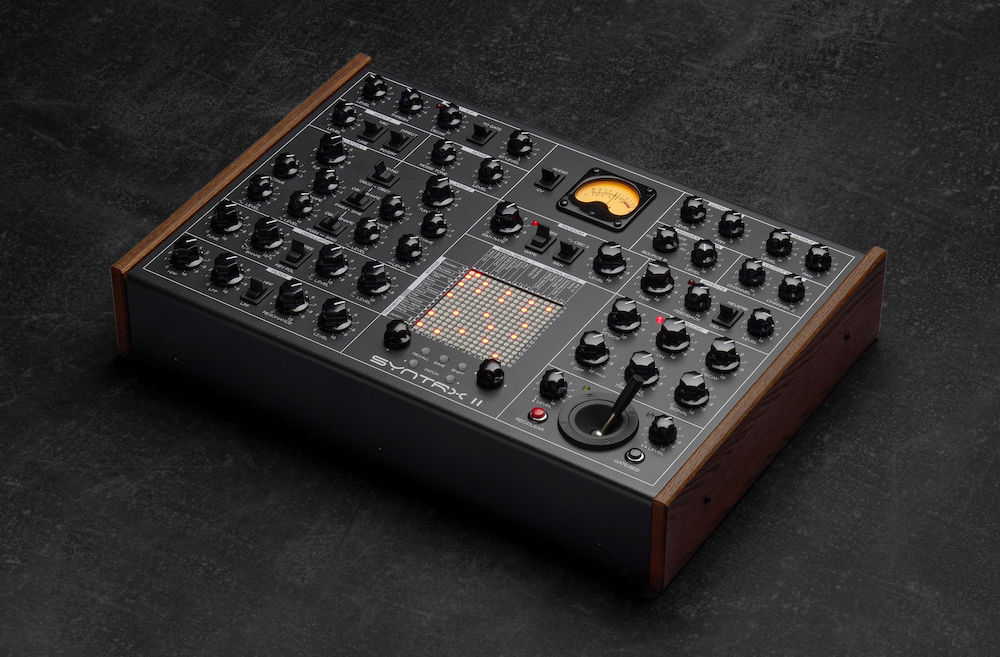Inspired by the legendary EMS Synthi, Erica’s compelling analogue synth gets an update. Greg Scarth finds out more.

The first thing you need to know is that the Erica Synths Syntrx II isn’t just a simple update of the original model. It’s still loosely inspired by the classic EMS Synthi – albeit categorically not a clone – but this time around the formula has changed quite significantly. It’s still an analogue, monophonic synth capable of stereo sounds, but the second-generation version is slightly more conventional and more versatile than the original.
Some of the changes from the Syntrx I are immediately obvious, notably the new colour scheme and the loss of the built-in speakers. Digging a bit deeper, the spring reverb has been swapped for a DSP-based reverb/delay circuit plus there’s now an external gate input as well as an envelope follower on one of the audio inputs. What’s harder to spot is that the movement of the joystick can now be recorded and replayed like automation, which ties in nicely with the new built-in sequencer. It also bucks the inflation trend, coming in more than £200 cheaper than the original (which is still available in very limited numbers).
Fundamentally, the approach of the Syntrx is almost entirely based around the Synthi-style patch matrix, a 16×16 grid of LEDs which represent the routing of ‘sources’ and ‘treatments’ to audio signal inputs and control voltage inputs. Positions on the matrix are dialled in Etch-A-Sketch-style using the two rotary encoders and activated instantaneously by pushing one of the two. Using the left-hand, Y-axis encoder, you can set up attenuated routing at 30% or 70% of the incoming level, allowing you to apply milder modulation. The patch matrix is buffered and mutlipled, meaning that you can mix any combination of 16 sources into any one destination, and likewise you can split any source into as many destinations as you want.

Each of the sections of the Syntrx’s synth architecture is entirely distinct, effectively set up like separate modules with no hard-wired routing between any of them. As such, you’ll need at least three or four connections patched on the matrix to get a basic synth sound with a filter and VCA envelope out of the Syntrx, but the depth of the synth is self-evident from the fact that you can potentially use as many of those 256 patch points as you want, simultaneously. Programming the Syntrx quickly ramps up in complexity as you explore the wealth of options on offer. It’s worth noting that Erica provide excellent support to help you get to grips with the creative potential of the Syntrx II, with a very good manual and excellent tutorials on the website, quickly getting into more advanced territory. The first patch note, Cross Saw 1, for example, requires 25 routings to be set up via the matrix, giving a ring-modulated stereo drone patch with rhythmic delays and joystick control.
The sequencer itself is a pretty simple affair, accessed by holding down Shift and pressing the Gate/Seq button next to the joystick. This brings up a piano roll of sorts on the matrix, with up to 16 steps and an internal clock, adjusted using the left-hand data knob. Lighting up dots on the matrix programs a monophonic pattern which can then be played as a loop. Notes can be shortened or tied by setting the gate length for each step, but there are no accents or swing (features which might be nice to see in future firmware updates, if possible). There is, however, the extra bonus feature of a stepped modulation source, accessed via holding the shift button and tapping the Y-axis encoder, giving you per-step modulation and automation. Stepped modulation is added (or subtracted) from the joystick position and routed along with it via the patch matrix, allowing you to transpose the modulation. Movement of the joystick can now also be recorded and played back, similar to Erica’s Black Series Joystick module, giving you even more modulation and automation options.

Matrix settings can be stored as presets and recalled on the fly, but the settings of the various sections of the synth are always based on the knob positions and not saved into memory. As a result, the random patch function of the matrix (activated by holding shift and hitting a patch select button) is surprisingly usable, unlike similar features on a lot of synths. By setting up a synth sound and then randomising the patch matrix, you’re effectively generating variations on the parameters you’ve dialled in. Not every random patch is useful, of course, but it only takes a second to generate a new one and you can quickly put together a few saved patch settings based on your original sound.
Included in the box are ten white card overlays which can be drawn on to remember settings and ‘recall’ them manually whenever you want. This old-school, extremely analogue approach raises some interesting questions about the best way to get the most out of the Syntrx. In the studio, you can take your time to recall patches, but as a self-contained unit the Syntrx obviously appeals as a live performance instrument too. Perhaps the best approach in that context is to set up a series of patches and sequences which flow from one to the next, and make notes regarding knob settings and parameters which work with each one. With 256 memory slots to play with, keeping notes seems like a good idea, especially if you want to create multiple sequences for any given patch.

The Syntrx II does have connectivity options to integrate it with other sound sources, sequencers and so on – you’ve got MIDI in and thru, CV/gate inputs and two audio inputs – but it’s categorically not really intended to hook up to other synths and become part of a broader hardware setup. Instead, a major part of the Synthi/Syntrx approach is that everything is self-contained. The Syntrx philosophy is almost entirely about working within the confines of its own enclosed system, getting the most you can out of that vast array of patching options, using the built-in sequencer and performing hands-on in real time with the one-function-per-knob front panel controls.
The Syntrx II is by no means an immediate synth, and that’s absolutely fine. Realistically, this probably isn’t an instrument for newcomers to analogue synthesis, most of whom would understandably baulk at the idea of spending over £1,800. Where the Syntrx II excels is in its depth and the way it encourages you to explore its almost infinite potential. There are limitations, as with any analogue instrument, but they only help to make the Syntrx a compelling, challenging device to master. Is it better than the original model? It’s less quirky in certain ways, but the updates for version II – particularly the sequencer and the new effects – make it a more capable synth as well as a more user-friendly one. The Syntrx II may be able to trace its roots all the way back to the start of the 1970s, but this is still a spellbinding all-in-one instrument which holds its own against classics like the Buchla Easel Command.
Greg Scarth
More info/buy